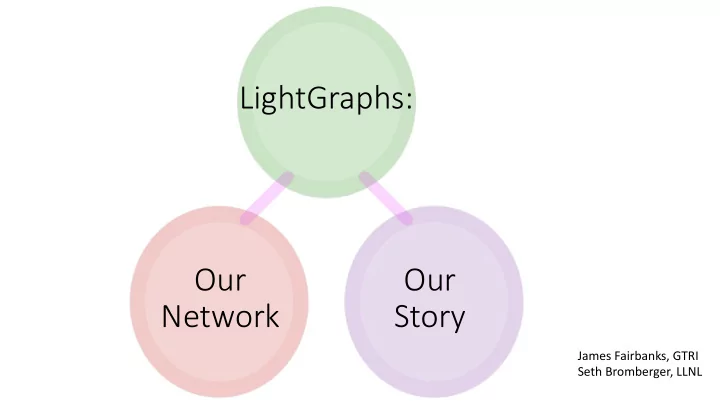

LightGraphs: Our Our Network Story James Fairbanks, GTRI Seth Bromberger, LLNL
About Seth • Security researcher focused on critical infrastructure • Looking at ways to combine graph analytics and machine learning to solve cybersecurity problems • NOT A MATHEMATICIAN
About James • Research Engineer focusing on online media and cybersecurity • Looking at ways to combine graph analytics and machine learning to solve cybersecurity problems • Used LightGraphs to study numerical accuracy requirements of spectral clustering • A MATHEMATICIAN
Why Should We Care About Graphs? • Uses of graphs in computer science: • Syntax Trees, Markov Chains, State Machines, Scheduling DAGs, … • Turns out that graphs are everywhere! • We focused on graph analysis: • Social media, cybersecurity, grid modeling (energy, transport, …)
In the beginning…. • Consulting for a client who wants to analyze activity logs • Graph representation of activity solves a pressing problem • Graphs.jl looks great. Let’s use it!
Graph Factory vs Graph Library • Generic Interfaces • Basic interface • Vertex List interface • Edge List interface • Vertex Map interface • Edge Map interface • Adjacency List interface • Incidence List interface • Bidirectional Incidence List interface
NetworkX • Simple to use • 1 language solution • Lots of features and analysis for complex networks • Dictionary of Dictionaries • Just too slow
LightGraphs Goals Simple Performant Consistent
Design Goals • Everything’s a tradeoff • Adjacency lists vs Sparse Matrices vs Dense Matrices vs…. • Vertex / Edge metadata? • Vertex indexing? • Edge sets? Edge iterators? Simple • Guides every decision we make. Performant Consistent
Sometimes we change direction • Adjacency lists: now sorted • Cost increase for graph creation / edge insertion (usually done once) • Cost advantage for all random edge accesses • “Parameterization is the devil” (@sbromberger, 2015) • Complexity increase • But: • memory savings for most graphs • flexibility for new graph types • forced us to define an interface • “Parameterize all the things!” (@sbromberger, 2017)
Example Design Tradeoff: Edge Sets • Originally, we used Set{Edge} to provide edge lookup lookup is beneficial in some cases, but leads to • • increased memory usage • slow edge insertion • Dropping this feature halved the memory usage of graphs, at the expense of edge lookup. • Users can still produce their own edge indices to accelerate lookup • Edge insertion is still faster, even with sorted adjacency lists
Reaping the rewards of Julian design • We are all figuring out what idiomatic Julian design means together Simple • We take advantage of types and multiple dispatch to achieve this design Performant Consistent
Advantages of Simplicity • One language: easy to develop • Fixed data structures: simple reasoning about performance • No metadata: simple to understand and use
Performance Benchmarks • Graph memory: • DiGraphs: Test LightGraphs NetworkX igraph graph-tool G1 = Erdos-Renyi (10k, 0.1) (s) 7.13 19 2.65 19.3 G2 = Barabassi-Albert (10k, 400) (s) 2.89 13.8 3.6 10.1 Betweenness (G2[1:3000]) (s) 4.02 DNF 6.77 3.34 Closeness (G2, s) 35.79 DNF 82 44.2 PageRank (directed G2, ms) 28.20 5 130 75.8 30.2 Local Clustering Coefficient (G2, ms) 255.53 37 400 167 270
Edge iterators use standard Julia interfaces • We use the iterator interface start, next, done in order to provide an iterator over edges for i in vertices(g) for j in neighbors(g, i) produce(i, j) end end • This leverages idiomatic Julia features to improve the readability of code. • Encourages “just write the loop” programming style instead of bulk operations with optimized primitives for e in edges(g) do work on e end
GraphMatrices: Encoding Math Errors into the Type System • For spectral graph theory you have to manage various “Graph Matrices” • {Combinatorial, Normalized, Stochastic, Averaging} {Adjacency, Laplacian} • Math errors are tricky because they don’t crash the code • Compiler/Type Errors crash the code • A “Matrix” type is too broad • Encoding math into the type system improves code verification and validation
Types and Dispatch lead to improved generalizability • GraphMatrices.jl was written for SparseMatrixCSC and then extended to support storing the graph as a LG graph. • You can compute the eigenvalues of a Graph Laplacian without making a sparse matrix copy. • Reduces memory overhead by a factor of 2
Abstraction Redux • Introduced AbstractGraph to allow more experimentation • Allows graphs that store metadata inside or outside of edges • Provides flexibility for Out-of-core / Parallel computation • Look to DifferentialEquations.jl and JuMP for inspiration on design • Weighted Graphs: LightGraphs.jl/pull/663
GSOC 2017 • Welcome Divyansh! • Focus on parallelizing expensive graph algorithms • To date: betweenness centrality, closeness centrality, and Dijkstra shortest paths • More planned
you should be using LightGraphs Why you • Single-language solution • Active developer community • Easy and fun to use Simple Performant Consistent Thanks to all contributors and the whole Julia community!
Recommend
More recommend